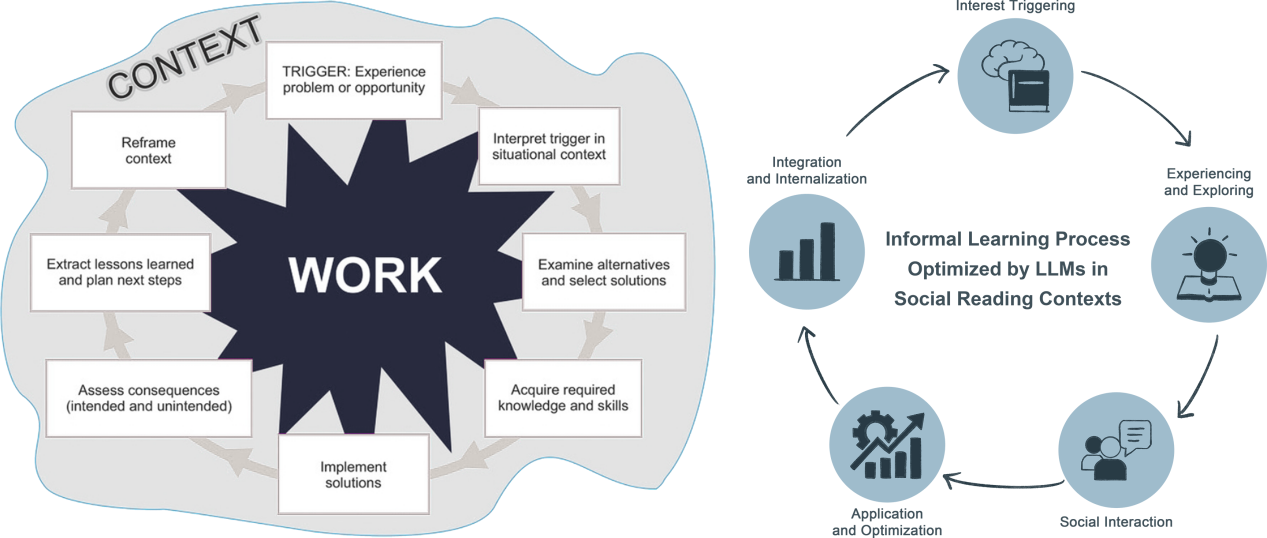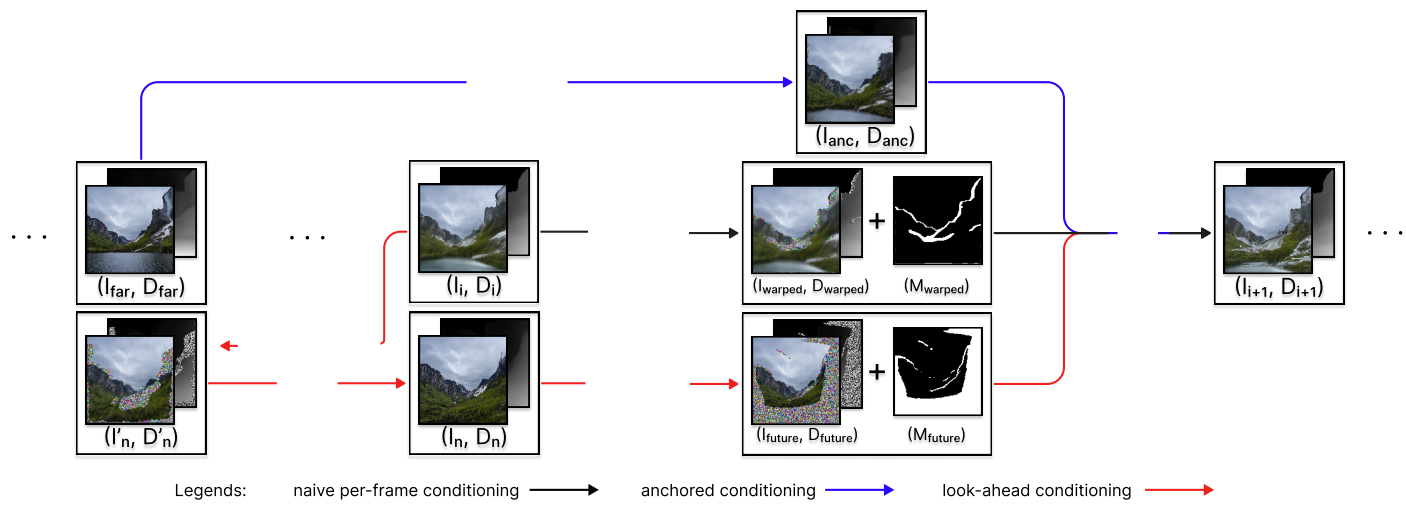

Volume 12 Issue 5
Published on August 2025
This study investigates how large language models (LLMs) can support informal learning in social reading environments. Focusing on critical thinking, collaborative knowledge construction, and group learning, it adopts a stage-based co-design approach grounded in an informal learning cycle. Two participatory design workshops were conducted with social readers, LLM experts, and interaction designers. Participants used first-person narratives and shared tasks to envision LLM-assisted learning processes. Thematic and visual analyses revealed three key design principles: stage-specific intervention, bidirectional prompting, and balancing individual autonomy with collaborative engagement. Building on these findings, we propose a conceptual design model illustrating how LLMs can facilitate social learning in future reading platforms. The study contributes to HCI by expanding the theoretical application of informal learning with LLMs, introducing a novel participatory method, and offering actionable insights for the development of AI-mediated social reading tools.

 View pdf
View pdf


This study examines 28 pairs of cognate disyllabic synonyms from Developing Chinese: Intermediate Comprehensive I, establishing a three-level classification system of “within-level,” “cross-level,” and “cross-band” distinctions based on the Chinese Proficiency Grading Standards for International Chinese Language Education. A questionnaire administered to 51 Central Asian students reveals that (1) cross-level synonym discrimination forms a cognitive pitfall (accuracy rate of only 59.15%), markedly lower than within-level (75.98%) and cross-band (74.59%) items. The main causes are conflicts across multiple dimensions (grammatical properties × affective connotation × situational constraints) and the mismatch of instrumental strategies (60.78% dependence on dictionaries). (2) Core difficulties lie in collocational differences (52.94%) and distinctions in affective connotation (52.94%), while a passive learning mode exacerbates pragmatic challenges. In response, the study proposes a three-dimensional pedagogical reconstruction framework: creating contrastive scenarios through dynamic contextual training, establishing a graded annotation system, and promoting explicit development of metacognitive strategies.

 View pdf
View pdf



Immigrant settlements established during late-imperial China reshaped coastal cultural landscapes in ways that conventional two-dimensional surveys only partially document. This study integrates centimetre-resolution terrestrial laser scanning, UAV photogrammetry, Qing-era cadastral maps and archival narratives into a GIS-driven three-dimensional semantic model that covers 1.04 km² of representative Ming–Qing heritage districts in Fujian (Zhangzhou tulou belt) and Guangdong (Guangzhou Xiguan mansions). A rule-driven ontology comprising forty-two classes links geometric primitives, walls, clan shrines, arcaded houses, to socio-ritual functions such as lineage worship, defensive organisation and intercultural trade. The workflow achieves a mean geometric root-mean-square error of 0.027 m, an overall semantic F1 of 0.892 and a processing throughput of 4.6 × 105 points s-1. Spatial analyses reveal statistically significant alignment (Rayleigh Z = 41.7, p < 0.001) between clan-hall axes and ancestral migration bearings, while variogram modelling of courtyard dimensions uncovers adaptive modulation to local hydrological regimes. By coupling dense reality capture with a culturally specific ontology, the research demonstrates that three-dimensional semantic GIS rigorously decodes immigrant cultural landscapes and supports evidence-based heritage conservation.

 View pdf
View pdf



IThis study engineers and rigorously validates a transformer–diffusion architecture that co-synthesises ultra-high-dynamic-range visuals, object-based ambisonic soundfields and broadband vibrotactile waveforms while maintaining inter-channel onset dispersion below 10 ms, thereby enabling an authentically embodied, cross-sensory screen aesthetic. Thirty-two adults participated in a within-subjects trial, viewing AI-enhanced and baseline clips inside a 270° cylindrical CAVE outfitted with 20 000-lumen RGB-laser projection, a 64-speaker wave-field-synthesis array and a 256-actuator haptic floor. Objective responses were captured through gaze-entropy, galvanic-skin-response amplitude and EEG beta-band desynchronisation, whereas subjective aesthetics were rated on a nine-factor inventory with Cronbach’s α = 0.92. The AI condition amplified the composite cross-sensory immersion index by 47.3 %, curtailed onset error from 23.5 ms to 8.7 ms and boosted aesthetic appraisal by 1.12 standard deviations. Hierarchical mixed-effects modelling (β = 0.57, p < 0.001) revealed that 71 % of the aesthetic uplift was mediated by temporal congruence, underscoring millisecond synchrony as a pivotal mechanism linking physical stimulus design to perceptual reward. Beyond confirming the causal potency of AI-driven synchrony, the work supplies reproducible calibration protocols, quantitative immersion metrics and a generalisable analytic toolkit for designers of next-generation multisensory content and display infrastructure.

 View pdf
View pdf



Based on holographic imaging technology, the online resources of "Basic Principles of Marxism" course generate intuitive images from abstract theories, create present situations from past history, and vivid thoughts from famous people’s speeches. It creates a holographic image database of historical artifacts, creatively constructs virtual reality scenarios, enhances the three-dimensional, experiential interactive nature of course display, and makes the courses more logical and systematic. The use of online small-class courses meets personalized learning needs, enhancing students’ cognitive abilities and fostering a better understanding of how theoretical principles emerge from practice and evolve through real-world applications. This approach cultivates practical talents with strong analytical skills and achieves notable educational outcomes.

 View pdf
View pdf



This article primarily looks at the evolution of textile practices from traditional domestic labour predominatly performed by women.It also studies how textiles have become an artistic and symbolic medium that expresses gender issues in a contemporary era. It reviews the history of how textile was integral to women’s daily duty in Eastern cultures particularly in ancient China. With the onset of the Industrial Revolution, women began to participate in textile manufacturing and played a major role in the field, signifying a shift from domestic to industrial labour and expanding their social roles. In the 1970s, due to a variety of social movements and growing attention of gender inequality in academic world, education institutions like the Bauhaus started to offer fibre art programs, providing female with more possibilities to access to creative and technical learning. Since then, fiber art also gained visibility as a form of feminist expression. Fiber art is a medium that helps women turn textile work into an art genre. This shift not only challenges conventional boundaries between craft and fine art but also encourages more woman to use fiber art to talk about their lives and gender roles in a society. The article follows these changes to show fiber art that not only helped women speak up through their work, but also displays a process of gender movements throughout its development.

 View pdf
View pdf


This paper critically evaluates the concept of Universal Basic Income (UBI) through a Marxist theoretical framework, addressing whether UBI represents a fundamental shift from traditional welfare towards genuine social emancipation or whether it primarily serves to reinforce existing capitalist structures. Employing classical Marxian concepts alongside contemporary Marxist theory—including Althusserian analyses of ideological state apparatuses and Marxist feminist perspectives—the paper scrutinizes global empirical data from UBI pilot programs and cross-national social spending comparisons. The findings reveal that although UBI experiments can mitigate extreme poverty and provide some degree of worker autonomy, they fail to challenge the underlying capitalist relations of production, exploitation, and class stratification. Instead, in certain neoliberal contexts, UBI potentially functions as a wage subsidy, weakening collective solidarity and shifting welfare responsibilities from capitalists to the state. The paper concludes that the emancipatory potential of UBI is contingent upon its political context, implementation strategy, and associated social reforms rather than inherent within the policy itself.

 View pdf
View pdf


In 19th-century America and early 20th-century Europe, the awakening of individual consciousness emerged as a central concern of literary exploration. Ralph Waldo Emerson’s Self-Reliance advocates for independence, self-affirmation, and inner moral sensibility, constructing an idealist philosophy of subjectivity. In contrast, Franz Kafka’s The Metamorphosis exposes the alienation, isolation, and collapse of the modern individual within familial and social structures. From a comparative literature perspective, this paper analyzes the notion of the “self” in these two works through the lenses of intellectual lineage, textual style, and sociocultural context. It aims to reveal the divergences in subjectivity shaped by differing cultural backgrounds and present a cross-temporal and cross-spatial dialogue of ideas.

 View pdf
View pdf


Han Kang’s The Fruit of My Woman and The Vegetarian are companion pieces of feminist writing, both centering on the “botanization” of women as a primary narrative device. However, despite their shared focus on the existential plight of East Asian women, the two works diverge significantly in thematic direction. This paper conducts a comparative study from five dimensions: thematic focus, strategies of resistance, social critique, philosophical implications, and the symbolic meanings of the endings, in order to identify the differences in how the two novels represent feminist “botanization.” The study finds that the former emphasizes loneliness and self-effacement within marital relationships, expressing an existential solitude through an inward turn of the body toward plant-like transformation. In contrast, the latter expands into a systemic indictment of patriarchy and societal discipline, using outwardly directed bodily self-destruction to challenge structures of social violence, and is marked by a strong ecofeminist tone. The progression in artistic expression and depth of thought between the two works reflects Han Kang’s sustained concern for the social existence of East Asian women. Together, they form a philosophical inquiry into the dehumanization of women amid the modernization process, a recurring motif throughout Han Kang’s literary corpus.

 View pdf
View pdf


This paper explores how survival is imagined in speculative fiction through the concept of relational knotting—a structure of suspended tension rather than resolution. Reading Rivers Solomon’s The Deep and Ursula K. Le Guin’s The Word for World is Forest, the essay argues that survival under the pressures of historical trauma, ecological collapse, and colonial violence requires the redistribution of pain across collective, more-than-human networks. Centralized suffering leads to fragmentation; only when memory and grief are shared—through community, ecology, and interspecies entanglement—can a durable form of survival emerge. Drawing on theoretical insights from Donna Haraway, Bruno Latour, and Dipesh Chakrabarty, this paper proposes a Knot Theory of Relational Survival, where knots signify the ethical practice of staying knotted—with others, with place, and with histories that resist resolution. These texts imagine survivance as ecological co-dwelling in a world that insists on unfinishedness.

 View pdf
View pdf




